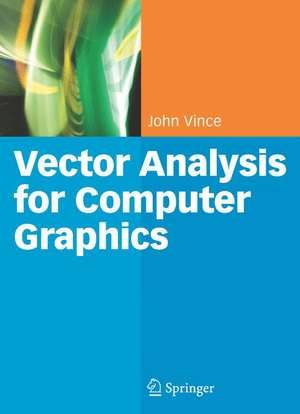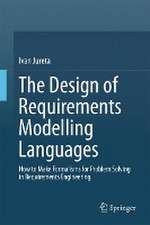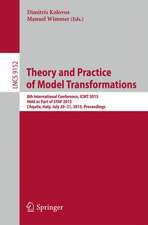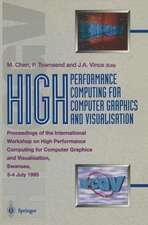Vector Analysis for Computer Graphics
Autor John Vinceen Limba Engleză Hardback – 18 iun 2007
| Toate formatele și edițiile | Preț | Express |
|---|---|---|
| Paperback (2) | 330.75 lei 6-8 săpt. | |
| SPRINGER LONDON – 3 iun 2022 | 330.75 lei 6-8 săpt. | |
| SPRINGER LONDON – 12 oct 2010 | 477.76 lei 38-44 zile | |
| Hardback (2) | 319.59 lei 38-44 zile | |
| SPRINGER LONDON – 18 iun 2007 | 319.59 lei 38-44 zile | |
| SPRINGER LONDON – 2 iun 2021 | 422.37 lei 6-8 săpt. |
Preț: 319.59 lei
Preț vechi: 399.48 lei
-20% Nou
Puncte Express: 479
Preț estimativ în valută:
61.15€ • 64.02$ • 50.60£
61.15€ • 64.02$ • 50.60£
Carte tipărită la comandă
Livrare economică 01-07 aprilie
Preluare comenzi: 021 569.72.76
Specificații
ISBN-13: 9781846288036
ISBN-10: 1846288037
Pagini: 259
Ilustrații: XIII, 259 p. 185 illus.
Dimensiuni: 178 x 235 x 20 mm
Greutate: 0.62 kg
Ediția:2007
Editura: SPRINGER LONDON
Colecția Springer
Locul publicării:London, United Kingdom
ISBN-10: 1846288037
Pagini: 259
Ilustrații: XIII, 259 p. 185 illus.
Dimensiuni: 178 x 235 x 20 mm
Greutate: 0.62 kg
Ediția:2007
Editura: SPRINGER LONDON
Colecția Springer
Locul publicării:London, United Kingdom
Public țintă
Academic/professional/technical: Research and professionalCuprins
Scalars and Vectors.- Vector Representation.- Straight Lines.- The Plane.- Reflections.- Intersections.- Rotating Vectors.- Vector Differentiation.- Projections.- Rendering.- Motion.
Recenzii
From the reviews:
"Vince’s book applies to more than computer graphics: it is a resource for many areas in applied mathematics. … Students in computer graphics courses would find it very useful if their class discussions moved into the mathematical fundamentals underlying the tools. … Undergraduate students especially lack the mathematics background that this book provides. … It is comprehensive and coherent, and a good addition to the library of any computational scientist." (Anthony J. Duben, ACM Computing Reviews, Vol. 49 (8), August, 2008)
"Vince’s book applies to more than computer graphics: it is a resource for many areas in applied mathematics. … Students in computer graphics courses would find it very useful if their class discussions moved into the mathematical fundamentals underlying the tools. … Undergraduate students especially lack the mathematics background that this book provides. … It is comprehensive and coherent, and a good addition to the library of any computational scientist." (Anthony J. Duben, ACM Computing Reviews, Vol. 49 (8), August, 2008)
Textul de pe ultima copertă
Vector analysis is relatively young in the history of mathematics, however, in the short period of its existence it has become a powerful and central tool in describing and solving a wide range of geometric problems, many, of which, arise in computer graphics. These may be in the form of describing lines, surfaces and volumes, which may touch, collide, intersect, or create shadows upon complex surfaces.
Vector Analysis for Computer Graphics provides a complete introduction to vector analysis, especially within the context of computer graphics. The author shows why vectors are useful and how it is possible to develop analytical skills in manipulating the vector algebra. Each topic covered is placed in the context of a practical application within computer graphics.
The book is divided into eleven chapters covering the mathematical foundations of vector algebra and its application to lines, planes, intersections, rotating vectors, vector differentiation, projections, rendering and motion.
Vector Analysis for Computer Graphics provides a complete introduction to vector analysis, especially within the context of computer graphics. The author shows why vectors are useful and how it is possible to develop analytical skills in manipulating the vector algebra. Each topic covered is placed in the context of a practical application within computer graphics.
The book is divided into eleven chapters covering the mathematical foundations of vector algebra and its application to lines, planes, intersections, rotating vectors, vector differentiation, projections, rendering and motion.
Caracteristici
Approaches vector analysis from a geometric standpoint, with an emphasis on applications in computer graphics
Notă biografică
Professor John Vince began working in computer graphics at Middlesex Polytechnic in 1968. His research activities centered on computer animation software and resulted in the PICASO and PRISM animation systems. Whilst at Middlesex, he designed the UK’s first MSc course in Computer Graphics and developed a popular program of short courses in computer animation for television designers. In 1986 he joined Rediffusion Simulation as a Research Consultant and worked on the development of real-time computer systems for commercial flight simulators. In 1992 he was appointed Chief Scientist of Thomson Training Simulation Ltd. In 1995 he was appointed Professor of Digital Media at the National Centre for Computer Animation at Bournemouth University and in 1999 he was made Head of Academic Group for Computer Animation. He was awarded a DSc by Brunel University in recognition of his work in computer graphics. He has written and edited over 45 books on computer graphics, computer animation, computer science and virtual reality, including the following Springer titles:
• Mathematics for Computer Graphics, 5th edition (2017)
• Calculus for Computer Graphics, 2nd edition (2019)
• Imaginary Mathematics for Computer Science, (2018)
• Foundation Mathematics for Computer Science, 2nd edition (2015)
• Matrix Transforms for Computer Games and Animation (2012)
• Expanding the Frontiers of Visual Analytics and Visualization (2012)
• Quaternions for Computer Graphics (2011)
• Rotation Transforms for Computer Graphics (2011)
• Geometric Algebra: An Algebraic System for Computer Animation and Games (2009) • Geometric Algebra for Computer Graphics (2008)
• Mathematics for Computer Graphics, 5th edition (2017)
• Calculus for Computer Graphics, 2nd edition (2019)
• Imaginary Mathematics for Computer Science, (2018)
• Foundation Mathematics for Computer Science, 2nd edition (2015)
• Matrix Transforms for Computer Games and Animation (2012)
• Expanding the Frontiers of Visual Analytics and Visualization (2012)
• Quaternions for Computer Graphics (2011)
• Rotation Transforms for Computer Graphics (2011)
• Geometric Algebra: An Algebraic System for Computer Animation and Games (2009) • Geometric Algebra for Computer Graphics (2008)
Descriere
Descriere de la o altă ediție sau format:
In my last book, Geometry for Computer Graphics, I employed a mixture of algebra and vector analysis to prove many of the equations used in computer graphics. At the time, I did not make any distinction between the two methodologies, but slowly it dawned upon me that I had had to discover, for the first time, how to use vector analysis and associated strategies for solving geometric problems. I suppose that mathematicians are taught this as part of their formal mathematical training, but then, I am not a mathematician! After some deliberation, I decided to write a book that would introduce the beginner to the world of vectors and their application to the geometric problems encountered in computer graphics. I accepted the fact that there would be some duplication of formulas between this and my last book; however, this time I would concentrate on explaining how problems are solved. The book contains eleven chapters: The first chapter distinguishes between scalar and vector quantities, which is reasonably straightforward. The second chapter introduces vector repres- tation, starting with Cartesian coordinates and concluding with the role of direction cosines in changes in axial systems. The third chapter explores how the line equation has a natural vector interpretation and how vector analysis is used to resolve a variety of line-related, geometric problems. Chapter 4 repeats Chapter 3 in the context of the plane.
In my last book, Geometry for Computer Graphics, I employed a mixture of algebra and vector analysis to prove many of the equations used in computer graphics. At the time, I did not make any distinction between the two methodologies, but slowly it dawned upon me that I had had to discover, for the first time, how to use vector analysis and associated strategies for solving geometric problems. I suppose that mathematicians are taught this as part of their formal mathematical training, but then, I am not a mathematician! After some deliberation, I decided to write a book that would introduce the beginner to the world of vectors and their application to the geometric problems encountered in computer graphics. I accepted the fact that there would be some duplication of formulas between this and my last book; however, this time I would concentrate on explaining how problems are solved. The book contains eleven chapters: The first chapter distinguishes between scalar and vector quantities, which is reasonably straightforward. The second chapter introduces vector repres- tation, starting with Cartesian coordinates and concluding with the role of direction cosines in changes in axial systems. The third chapter explores how the line equation has a natural vector interpretation and how vector analysis is used to resolve a variety of line-related, geometric problems. Chapter 4 repeats Chapter 3 in the context of the plane.























